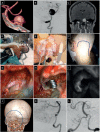Far Lateral Approach
- PMID: 35441601
- PMCID: PMC9179055
- DOI: 10.23750/abm.v92iS4.12823
Far Lateral Approach
Abstract
The far lateral approach is an inferolateral extension of the lateral suboccipital approach. Designed for clipping of the aneurysms of the vertebrobasilar junction and proximal segments of the posterior inferior cerebellar artery, it became over the years a workhorse approach for ventral foramen magnum meningiomas and other intradural lesions located anterior to the dentate ligament. This article summarizes the technical key aspects of the far lateral approach and transcondylar, supracondylar, and paracondylar extension.
Figures




References
-
- Heros RC. Lateral suboccipital approach for vertebral and vertebrobasilar artery lesions. J Neurosurg. 1986;64(4):559–562. - PubMed
-
- Day JD, Fukushima T, Giannotta SL. Cranial base approaches to posterior circulation aneurysms. J Neurosurg. 1997;87(4):544–554. - PubMed
-
- Bertalanffy H, Seeger W. The dorsolateral, suboccipital, transcondylar approach to the lower clivus and anterior portion of the craniocervical junction. Neurosurgery. 1991;29(6):815–821. - PubMed
-
- de Oliveira E, Rhoton AL,, Jr, Peace D. Microsurgical anatomy of the region of the foramen magnum. Surg Neurol. 1985;24(3):293–352. - PubMed
MeSH terms
LinkOut - more resources
Full Text Sources

